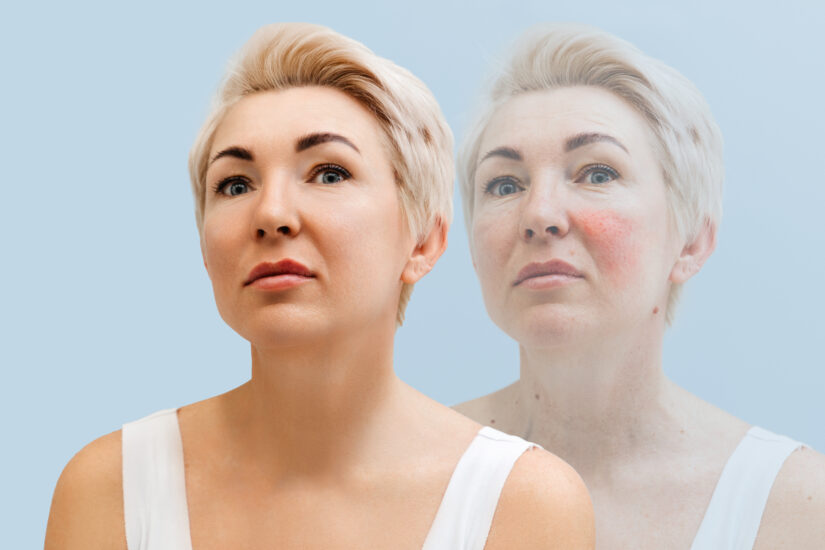IS ROSACEA BEHIND THAT RASH?

How can a disease that affects 16 million people be a mystery to most of us? Rosacea is a disease of the facial skin that looks a bit like acne, but feels and develops differently.
The real truth is rosacea could be disrupting the well-being of you or a loved one without even knowing you have it. To identify rosacea and distinguish it from acne, Midwest Dermatology encourages you to ask the following questions:
- Do you have redness on your nose and cheeks that won’t go away?
- When your face gets flushed, does the flushing last at least one hour?
- Are there red, sore pimples and small pus-filled bumps on your face that won’t go away?
- Are there visible, broken blood vessels on your face?
- Does exposure to the sun cause redness that doesn’t go away for days?
- Are your eyes watery and bloodshot frequently? Do your eyes frequently burn, itch and sting?
- Do you feel warm and flushed after drinking alcohol or eating spicy foods?
- Has your nose become bigger and reddened noticeably over the years?
If you answered “yes” to more than one of these questions, Midwest Dermatology recommends you talk to one of our physicians about rosacea. This is especially important as early diagnosis can help stop the disease from spreading.
Managing the Symptoms
Rosacea is a chronic disease, which means it can only be treated, not cured. Once you’re diagnosed, the only question that really matters to you is “how can I manage it”? The first step is working with Midwest Dermatology to determine the subtype or subtypes affecting you. There are FOUR SUBTYPES, each with different symptoms and patterns.
SUBTYPE 1: involves facial flushing and persistent redness, as well as visible blood vessels.
SUBTYPE 2: is characterized by persistent redness and little bumps and pimples that come and go.
SUBTYPE 3: features skin thickening and the nose may become enlarged.
SUBTYPE 4: affects the eye area. Eyes get dry, or may become watery and eyelids get red and irritated.
Fortunately, Midwest Dermatology has a number of treatments that our physicians can prescribe to closely target the most difficult symptoms in each subtype, including:
- PRESCRIPTION TOPICALS like Mirvaso and Rhofade that work quickly to diminish and lessen facial redness, which is a hallmark of rosacea. Other prescription creams are available to treat pustules and papules – those pimple-like lesions – including Metrogel, Azelex, Finacea, and Soolantra. Your Midwest Dermatology physician will review your history and examine your skin to determine the best combination of prescription treatments.
- ORAL ANTIBIOTICS – a tried and true treatment for rosacea includes prescription drugs minocycline and doxycycline, two antibiotics taken by mouth to reduce redness and pimples.
- PULSED LIGHT LASER THERAPY – in office procedure that gently targets the redness and eliminates rosacea’s telltale broken blood vessels on the face.
FIND YOUR TRIGGERS
Today, more and more people are turning to Midwest Dermatology for help in recognizing rosacea and treating its symptoms. Our physicians approach to treating rosacea not only includes effective treatments, but also is a process to understand a patient’s personal rosacea triggers. Things that might seem mundane or normal to some people like sun exposure or having an alcoholic beverage, even taking a walk on a windy day may trigger an outbreak of rosacea symptoms. Other rosacea triggers include:
- Hot beverages
- Spicy foods
- Stress
- Facial products (creams, lotions, makeup, etc.)
- Temperature and other weather changes
- Exercise
- Certain medications
Once you and your physician uncover your triggers, you’ll set up a plan to avoid them. Your strategy may also include a trip to our aesthetician for counseling on sunscreens, cleansers and moisturizers that work best with rosacea-prone skin.
Interested in being screened for rosacea and starting on a treatment plan? Call Midwest Dermatology at (402) 933-0800 to schedule an appointment at one of our six convenient locations.
